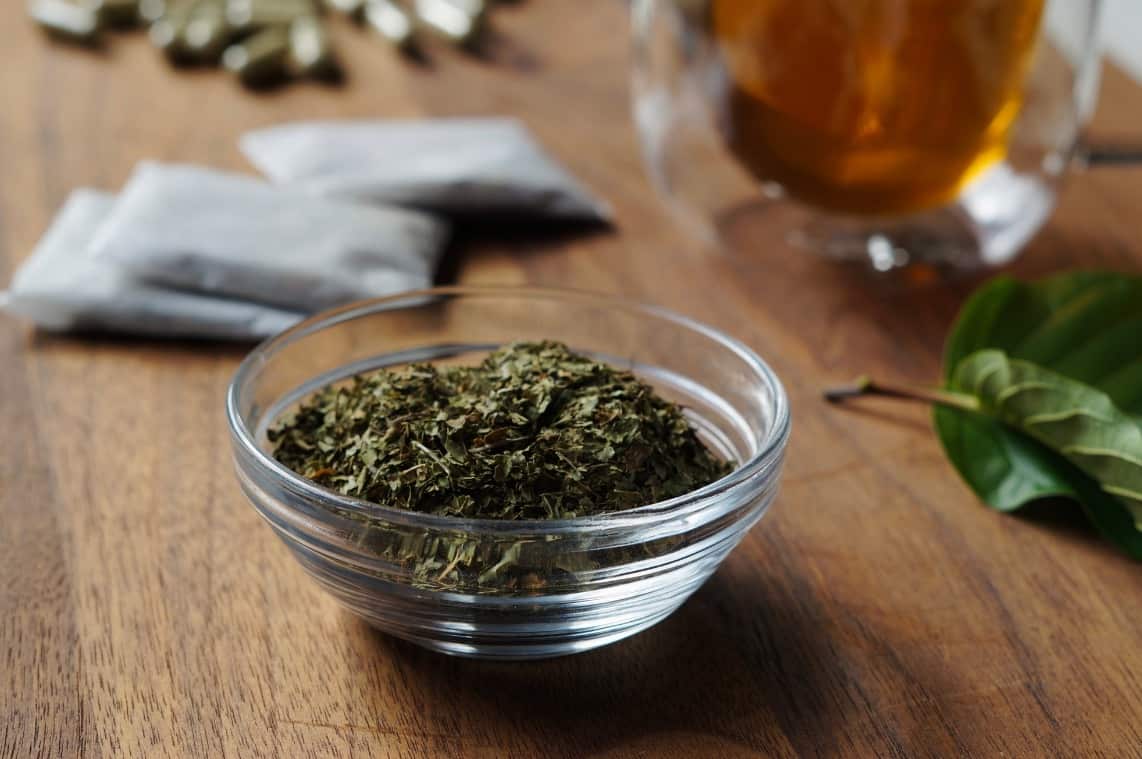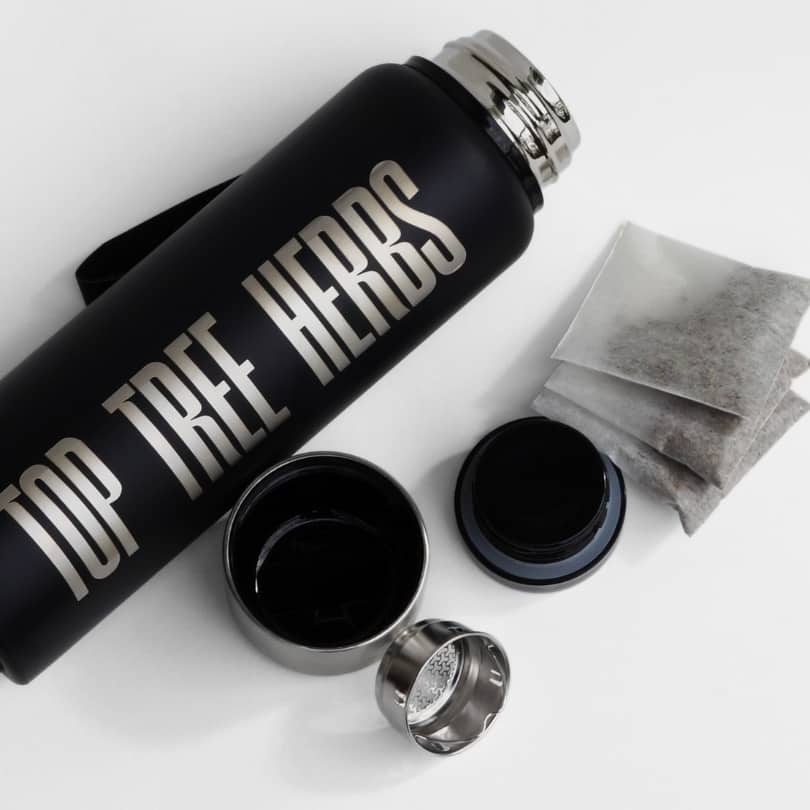There are dozens of different suggestions people give on how to make kratom tea. So out of all of the possible methods, what’s the best way to make kratom tea?
The Top Tree team has dedicated thousands of hours to answering this question. We’ve considered brewing temperatures, steep times, flavor additions, and other variables to create the best, easiest mug of tea.
Below the recipe, you’ll find all the details and tips you need to know to make tea with kratom that is both effective and tastes great.

How to Make Kratom Tea: Easy Directions
Prep time: 3 minutes
Steep time: 15-25 minutes
Servings: 1
Kratom Tea Ingredients
- 1-2 kratom tea bags or 3-6 grams of loose-leaf kratom
- 8-16 oz water
- 1 tbsp lemon juice (about half of a small lemon), more or less to taste
- 1-2 tsp sweetener of choice, more or less to taste
Equipment
Thermos Directions
- Add your tea bags or loose-leaf kratom to your thermos. Squeeze lemon juice over the tea bags.
- While the tea is soaking in the lemon juice, bring your water to a boil. Immediately pour the boiling water into your thermos and cap it. Let the tea steep for at least 15 minutes.
- If you are using loose leaf tea and your thermos does not have a built-in strainer, pour the tea through the fine mesh strainer into a mug.
- Sweeten to taste, allow to cool, and enjoy hot or over ice.
Stovetop Directions
- Add your tea, lemon juice, and cold water to the pot. Bring to a boil, then cover and reduce to a simmer. Continue to heat at a low simmer for at least 15 minutes.
- If using kratom tea bags, remove them with a spoon then transfer your tea to a mug. If using loose leaf tea, carefully pour the tea through a fine mesh strainer into your mug.
- Sweeten to taste, cool, and enjoy hot or over ice.
Behind the Recipe: the Science & History of Making Kratom Tea
We didn’t pull the recipe above out of thin air. It was created after years of learning kratom science, studying traditional kratom practices, and then brewing hundreds of mugfuls of tea. Here are all of the topics we’ll get into below:
- Where does kratom come from?
- Why you shouldn’t make kratom tea the same way you’d brew other types of tea
- Serving size guide
- Brewing method overview & FAQs
- Pro tips & tricks
- Specialty kratom recipes
Where Kratom Originated
Kratom is a common term for the Mitragyna speciosa tree and its leaves. M. speciosa is an evergreen tree that naturally grows throughout Southeast Asia.

Like coffee plants, which produce the alkaloid caffeine, kratom trees produce alkaloids that have psychoactive effects.
Kratom leaves do not contain caffeine, so kratom tea is naturally caffeine-free. Typically, the most abundant alkaloid found in kratom leaves is mitragynine.
Why You Shouldn’t Make Kratom Tea the Same Way You’d Brew Other Types of Tea
Caffeine, the primary active alkaloid in coffee and black tea, is highly water soluble. On the other hand, mitragynine and other kratom alkaloids are not highly water soluble.
While you can steep coffee or black tea for just 2-7 minutes to make a strong brew, this won’t be long enough to make a strong cup of kratom tea. That’s why it isn’t effective to put a kratom tea bag in a mug of hot water or a French press.
Traditionally, Southeast Asian communities prepared kratom tea by simmering leaves in water over a fire for two or more hours. However, it’s possible to make a strong cup of tea in much less time by following the brewing instructions below.
Some kratom brands or forums will tell you to brew kratom tea the same way you would brew chamomile tea or peppermint tea, but this isn’t well-informed advice.
American Kratom “Tea” Practices vs. Kratom Tea Traditions in Thailand
In modern-day America, most kratom consumers buy kratom powder. Companies and consumers oftentimes call this powder “tea,” but they rarely consume it the way you’d consume a true tea, herbal tea, or even matcha powder.
Typically, people swallow the powder and chase it with water or mix it into water or juice. People also swallow powder in kratom capsules or tablets.
Yet in Thailand, people have rarely swallowed kratom leaf material. Traditionally, there were two main ways to get the benefits of kratom. The first was just chewing the kratom leaves and spitting them out. The second was—you guessed it—brewing the leaves into a tea.
Kratom is now cultivated on farms, but was originally just a wild-growing tree. In Thailand and other regions where kratom trees grow naturally, farmers and other laborers could simply pluck a leaf off of a tree whenever they needed a boost of motivation.
They would chew the leaves to stave off exhaustion and hunger, which allowed them to increase their productivity. In addition to having kratom as a daytime work-enhancing tool, people in Thailand commonly have it at night to unwind.
Great Uses for Kratom Tea
This tea is great to drink by yourself or with friends in situations when you might otherwise have a cup of coffee, a mug of herbal tea, or a beer. It’s recommended for:
- Caffeine-free motivation
- Socializing
- Pre-workout energy
- Post-workout recovery
- Afternoon pick-me-up
- Evening rest & relaxation
Want more details on what kratom tea is commonly used for? Here are 18 things kratom is great for—and what it’s NOT meant for.
Serving Size Guide: How to Make Kratom Tea the Right Strength
There are different methods for making tea which result in different tea strengths, and thus different effects. So you can learn to use one box of tea bags to make kratom drinks that have fairly different effects. Here are common serving size ranges and effects:
- 1-2 servings: effects are energizing
- 2-3 servings: effects are commonly balanced and focusing
- 3-4 servings: effects are usually more calming and soothing
This is just a general guide, though. The amount of tea you should actually consume depends on a few other factors. These can include:
- Your body size and metabolism
- Your experience level with kratom
- The context in which you brew tea (such as with an empty stomach, after a meal, or during exercise)
- Other supplements or medications you are taking
We always recommend starting small to see what works best for you personally. Don’t forget to speak with your healthcare provider before introducing kratom or other new botanicals into your routine, especially if you have a health condition or are taking medications.
Most Common Kratom Varieties and Their Typical Effects
There are different types of kratom that are commonly recommended for different purposes:
- White vein tea: Typically the go-to brew for staying motivated and upbeat. You might like white vein tea as a coffee alternative or pre-workout.
- Red vein tea: Often consumed for relaxation and relief, or for resting after a hard workout.
- Green vein tea: Usually provides a balance between the energizing effects of white vein kratom and the relaxing effects of red vein kratom. Great as an afternoon pick-me-up or a night out.
Related: Kratom Serving Size Guide: How to Choose the Right Amount
Keep in mind, the vein color of your kratom isn’t always the most important piece of the kratom puzzle.
In fact, there is ongoing research into the effects isolated kratom alkaloids, the interaction between many kratom alkaloids, and even the impact of marketing on peoples’ kratom experiences.
Brewing Methods to Make the Best Kratom Tea
Now that we’ve covered the basics of serving sizes and uses, let’s go over the how of how to make kratom tea.
It’s great to recognize and understand the Southeast Asian traditions. There are hundreds of years of anecdotal reports that provide insight into the best way to make kratom tea. However, that doesn’t mean you can’t use modern brewing techniques and equipment to make the process easier and more convenient.
Comparing Kratom Powder, Crushed Leaf Kratom, Whole Leaf, and Tea Bags
First, you’ll need your kratom. We always recommend whole leaf or crushed-leaf kratom, loose or in tea bags, to make the best kratom tea.

There are ways to make tea with powder, but we really don’t recommend doing this. It’s difficult and time-consuming to make kratom tea from powder. Usually you’ll end up with a gritty, bitter tea.
Related: Why Brew Tea with Crushed Leaf Kratom Instead of Making Tea with Powder?
Dried kratom leaves, either whole or crushed, are the best option for making great tea. These larger particle sizes are a lot easier to strain out. This means you’ll have an easy brewing process and great-tasting tea.
For the most convenient brew, you can get crushed-leaf kratom in tea bags. These are pre-weighted with the recommended serving size, so you don’t have to do any measuring before you brew. Plus, you don’t have to do any straining, so brewing with tea bags is overall far less messy than brewing with loose leaf kratom or powder.
Boiling vs. Hot Water: Ending the Controversy
Some guides on how to make kratom tea claim that using boiling water can cause the alkaloids to degrade. This is largely a myth, however.
Top Tree Herbs’ founders partnered with kratom researcher Dr. Oliver Grundmann to study this contentious topic. Dr. Grundmann found that the amount of alkaloids extracted with boiling water is much higher than the amount extracted with very hot water.
So don’t be afraid to steep your kratom leaves in boiling water.
How Long to Steep Kratom Leaves
Choose the length of time to steep your tea based on the strength of tea you want.
- Lighter: Steep your tea for 10 to 15 minutes, or use a smaller amount of kratom.
- Stronger: Steep your tea for 30 minutes or longer. Alternatively, you can do a shorter steep with a larger amount of kratom.
Kratom’s long steep time is why we recommend you either simmer your tea on the stove or steep it in an insulated thermos.
Recommended Brewing Equipment
To keep your kratom hot for the duration of the steeping time, steep it in something that won’t lose heat quickly. Put down your coffee mug and instead grab a thermos, an insulated mug, or a small pot.

If you brew with kratom tea bags, you won’t need any other equipment. If you brew with loose leaf kratom, you’ll need to strain the tea once you’ve finished steeping it. You can use a thermos with a removable strainer, an insulated French press, a tea ball, or a regular mesh strainer.
Use Lemon Juice to Make Strong Kratom Tea Quicker
Increasing the acidity of your water can help you make stronger kratom tea because it increases the solubility.
At home, you can make your water acidic by adding lemon juice, lime juice, or another food-safe acid. This can also reduce the total brew time necessary to make strong kratom tea.
Without the acid, your tea might be slightly less intense. If that’s your preference, perfect! If not, you can make up for the lack of acid by keeping your kratom steeping for longer. Some people steep their tea for 30 minutes, and others leave it to steep for a few hours (or overnight).
Batch Brewing and Storing Leftover Tea
You can make a large batch brews of kratom tea to share with friends or to save time by brewing a few days’ worth at once.
If you plan on storing your kratom tea in the refrigerator for a while, you might not want to add an acid. Mitragynine is acid-labile. This means acid slowly breaks down the alkaloid into different, inactive molecules.
It probably won’t make a big difference if you plan to drink your tea within 24 hours. However, more research is needed to determine exactly how quickly this degradation process happens, with or without the added acidity.
Tips for Getting the Most Out of Your Kratom Tea
No matter which way you brew, there are a few ways to get more bang for your buck, and to make the process more convenient and fun.
1. Re-Steep
You can reuse kratom tea bags. Drink your first cup of tea after steeping the leaves for 15-20 minutes. Then, add more water and steep the same tea bags a second time.
The second cup of tea will likely be slightly weaker than the first one, but it will be active nonetheless. You may even be able to get a third cup of tea out of the same kratom tea bags depending upon how long you steep them.
2. Use a thermos for convenience & travel
Thermoses aren’t just great for brewing effective tea, they’re also great for keeping your tea hot or cold on the go. They’re great for work, hiking, or even bringing your kratom on a plane.
3. Prep Tea Before Bed to Have It Ready First Thing in the Morning
Want to drink a strong cup of kratom tea as soon you roll out of bed in the morning? Prep your tea in a thermos before bed. Then, leave it on your bedside table so you can enjoy it first thing in the morning.
4. Try Brewing with Other Ingredients for Added Flavor
If you don’t like the taste of plain kratom tea, try adding flavors like fresh ginger, a drop of vanilla extract, or a sprig of mint. Here are some of the best specialty kratom tea recipes:
Another easy way to make delicious tea is to use botanical kratom blends. These are tea bags that contain both crushed-leaf kratom and a blend of functional herbs and spices.
For their blends, Top Tree Herbs specifically sources herbs and spices that can be brewed for the same amount of time as kratom leaves. Here are Top Tree’s flavored kratom tea options:
- Chai Unwind: a blend of red vein kratom with rooibos, chamomile, and warm chai spices
- Tulsi Balance: a blend of green vein kratom with tulsi, rooibos, peach, and mango
- Cacao Uplift: a blend of white vein kratom with cacao shells.
5. Make Iced Tea for Less Bitterness
In addition to alkaloids, kratom contains other compounds like tannins that can be bitter. Chilling your tea can really help mellow out the natural bitterness of the kratom. Pour your tea over ice, or leave it in the fridge to chill for a few hours.
Now that we’ve dug into the details for making the best tea with kratom, let’s put all of this information together in an easy-to-follow recipe.
Cheers to Better Brewing!
No matter what purpose you’d like to make kratom tea for, you’ll now be equipped with the information you need to make the best kratom tea imaginable.
If you want to learn even more, you can explore other kratom brewing methods and kratom information and news on the Better Brewing Blog.

